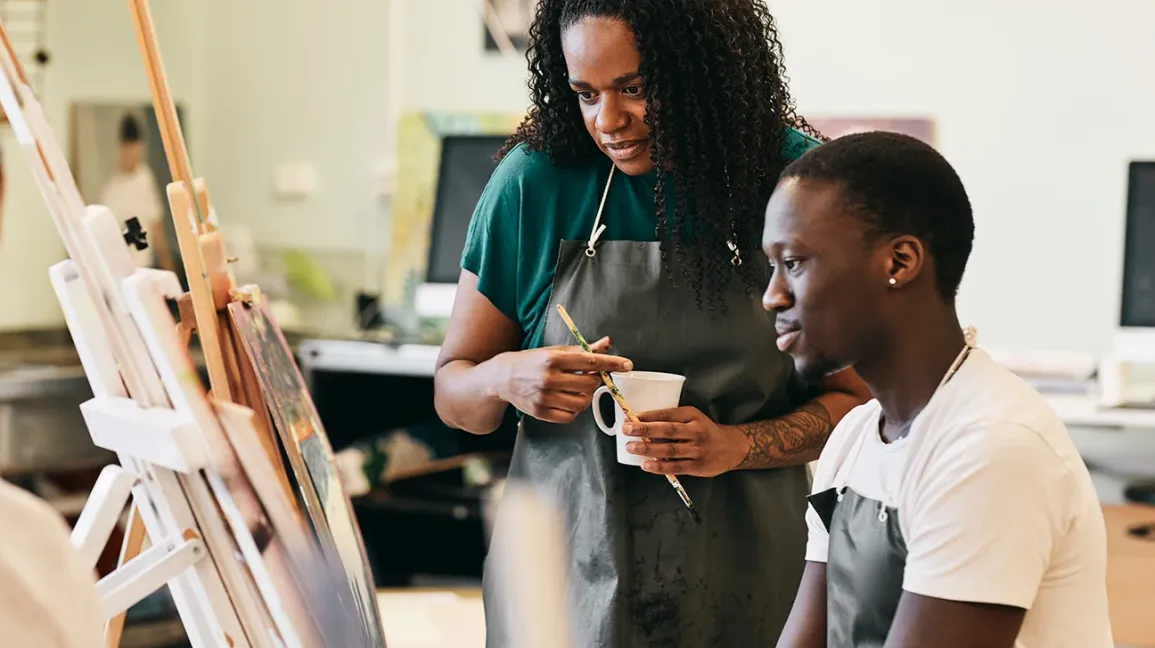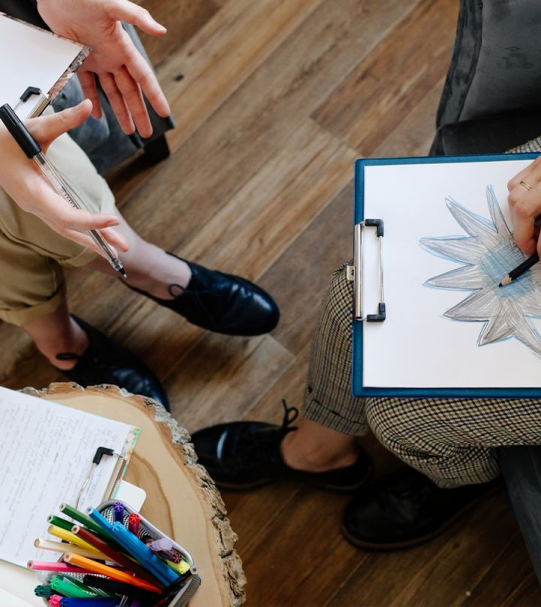
Creative Art Therapy for Addiction Recovery at Wellbridge
Engage With Your Creativity and Heal From Within

Interacting with your creative side in addiction recovery can be a transformative component of holistic care. Creative art therapy offers people a unique outlet to explore and express their emotions, thoughts, and experiences in a safe, supportive environment.[1] Through various artistic mediums—such as painting and music—you can tap into your inner self and process the complex emotions often associated with addiction.
At Wellbridge, we recognize the potential of incorporating creative art therapy into addiction recovery programs. Our creative addiction treatment program combines evidence-based practices with holistic modalities to address the diverse needs of all our patients. By nurturing creative expression alongside traditional therapeutic interventions, we strive to support you every step of the way in the recovery journey, helping you rediscover joy, meaning, and purpose in life beyond addiction.
At Wellbridge, all patients engage in Art Psychotherapy groups with an opportunity for individual art therapy sessions. This allows our patients to tap into their subconscious and begin to process their trauma and how this contributes to their substance use disorder. We also offer creative expression groups where patients will have the opportunity to explore various art materials including but not limited to drawing, painting, collage, and clay.
What are Creative Arts Therapies?
Creative arts therapies encompass a range of therapeutic approaches that utilize various forms of creative expression to promote healing, growth, and well-being.[2] These therapies integrate creative mediums into the therapeutic process, allowing you to explore and address emotional, psychological, and social challenges:[3]
-
- Art Therapy: Art therapy involves the use of visual art mediums such as drawing, painting, pottery, and sculpting to help individuals explore their thoughts, feelings, and experiences. Through the creative process, individuals can gain insight into subconscious emotions, express themselves non-verbally, and develop coping skills.
What Can Creative Arts Therapy Help With?
There are several benefits of art therapy when it comes to addressing a wide range of substance abuse and co-occurring challenges:[4]
- Addiction recovery: Creative arts therapies offer individuals in addiction recovery a non-verbal means of expression to explore underlying emotions, triggers, and coping mechanisms. Engaging in creative activities can help you manage cravings, reduce stress, and build resilience on the journey toward sobriety.
- Trauma: Creative arts therapies provide a safe and supportive space to process traumatic experiences and work through associated symptoms such as anxiety, depression, and post-traumatic stress disorder (PTSD). Through creative expression, people can externalize their trauma narratives, regain a sense of control, and promote healing and resilience.
- Co-occurring mental health issues: Creative arts therapies can be effective in managing symptoms of various mental health conditions, including depression, anxiety, bipolar disorder, and more. Engaging in creative activities can improve mood, enhance self-esteem, and create a sense of empowerment and agency.
- Stress reduction: Participating in creative arts therapies can help individuals reduce stress levels and promote relaxation. Activities such as painting, music-making, and dance can serve as outlets for emotional expression, leading to a sense of catharsis and emotional release.
- Identity development: Creative arts therapies provide opportunities for people to explore their inner thoughts, feelings, and identities in a supportive and nonjudgmental environment. Through creative expression, you can gain insight into your values, beliefs, and life experiences, fostering self-awareness and personal growth.
What Are the Benefits of Creative Arts Therapies?
Art psychotherapy for addiction recovery offers a range of benefits for those seeking to improve their overall health and well-being. Some of the key benefits include:[5]
- Emotional expression: Creative arts therapies provide a non-verbal means of expressing complex emotions that may be difficult to articulate verbally. Engaging in creative activities helps you explore and process your feelings in a safe and supportive environment.
- Insight: Creative arts therapies facilitate self-exploration and introspection, allowing people to gain insight into their thoughts, feelings, and behaviors. Through creative expression, individuals can uncover hidden aspects of themselves, identify patterns, and develop a deeper understanding of their experiences.
- Enhanced self-esteem: Engaging in creative activities can boost self-esteem and confidence by providing opportunities for mastery and self-expression. Accomplishing artistic goals, receiving positive feedback, and seeing tangible results of creativity can foster pride and accomplishment.
- Coping skills development: Creative arts therapies develop effective coping skills for managing difficult emotions and challenging situations. Through creative expression, you’ll learn adaptive ways of coping with stress, anxiety, and other mental health concerns.
- Social connection: Participating in group-based creative arts therapies can foster social connection and support among people facing similar challenges. Collaborative creative activities promote empathy, understanding, and camaraderie, reducing feelings of isolation and loneliness.
- Holistic healing: Creative arts therapies promote holistic healing by addressing the interconnectedness of mind, body, and spirit. By engaging in creative expression, you can tap into your innate creativity and resilience, cultivating more overall well-being and vitality.
How and Why Creative Arts Therapy Works
Creative arts therapies operate through a multifaceted connection of psychological, neurological, and social mechanisms, leveraging the innate human capacity for creativity and expression to foster mental health and well-being.[6]
By providing you with structured channels for emotional expression, creative arts therapies contribute to emotional regulation. Studies have demonstrated that engagement in creative activities like art-making or music-making can lead to measurable reductions in cortisol levels, the stress hormone, thereby inducing feelings of relaxation and alleviating psychological distress.[7]
These therapies promote self-awareness and personal growth by providing a medium through which you can externalize and explore your innermost thoughts and emotions.[8] Creative expression can serve as a catalyst for profound insights and transformative experiences, leading to increased self-understanding and empowerment.
What to Expect With Creative Arts Therapy
Engaging with creative arts therapies at Wellbridge means you’ll be discovering new things about yourself during your recovery. The integration of creative arts therapies into our comprehensive approach to wellness ensures a unique and enriching experience for people seeking to nurture their mental health and well-being.
In Wellbridge’s Creative Arts Therapy building, you can expect a supportive and nurturing environment where your individual needs and preferences are prioritized.
Our approach emphasizes the interconnectedness of mind, body, and spirit, empowering you to cultivate more resilience, better balance, and inner harmony.
Frequently Asked Questions About Creative Arts Therapy for Addiction
Can art therapy sessions for substance abuse be used alongside traditional addiction treatment methods?
Yes, creative arts therapies can effectively complement traditional substance use disorder treatment methods. They offer a holistic approach that addresses the emotional, psychological, and social aspects of addiction recovery, enhancing the overall treatment experience.
By integrating creative expression with evidence-based practices such as counseling, group therapy, and medication-assisted treatment, individuals in recovery can benefit from a more comprehensive and personalized approach to healing.
Who can benefit from participating in creative arts therapy programs for substance abuse treatment?
Anyone struggling with addiction and co-occurring behavioral health issues can benefit from participating in creative arts therapies. These therapies offer a unique and accessible pathway to explore and address underlying issues related to addiction, regardless of age, gender, or background. Whether you’re new to recovery or have been on your journey for some time, creative arts therapies provide valuable tools for self-expression, insight, and personal growth.
Do I need to have artistic talent or experience to participate in creative arts therapies?
No artistic talent or experience is required to participate in creative arts therapies in drug rehab. These therapies focus on the process of creative expression rather than the end product, emphasizing self-discovery, emotional exploration, and personal growth.
Therapists who specialize in creative arts therapies are trained to create a supportive and non-judgmental environment where individuals of all skill levels can feel comfortable exploring their creativity. Whether you’re a seasoned artist or have never picked up a paintbrush, art therapy for recovering addicts has great therapeutic value for addiction recovery in the recovery process.
Sources
[1] Smith, A. (2021, March 9). Creative therapy: Types, benefits, and more. Www.medicalnewstoday.com. https://www.medicalnewstoday.com/articles/creative-therapy on May 15, 2024
[2] Theresa Van Lith, & Ettenberger, M. (2023). Arts-based therapies, practices, and interventions in health. BMC Complementary Medicine and Therapies, 23(1). https://doi.org/10.1186/s12906-023-04177-4 on May 15, 2024
[3] Hu, J., Zhang, J., Hu, L., Yu, H., & Xu, J. (2021). Art Therapy: A Complementary Treatment for Mental Disorders. Frontiers in Psychology, 12(34456801). https://doi.org/10.3389/fpsyg.2021.686005 on May 15, 2024
[4] Tiret, H. (2017, May 25). The Benefits Art Therapy Can Have on Mental and Physical Health. MSU Extension. https://www.canr.msu.edu/news/the_benefits_art_therapy_can_have_on_mental_and_physical_health on May 15, 2024
[5] Shukla, A., Choudhari, S. G., Gaidhane, A. M., & Quazi Syed, Z. (2022). Role of Art Therapy in the Promotion of Mental Health: a Critical Review. Cureus, 14(8). https://doi.org/10.7759/cureus.28026 on May 15, 2024
[6] Goodill, S. W. (2010). The creative arts therapies: making health care whole. Minnesota Medicine, 93(7), 46–49. https://pubmed.ncbi.nlm.nih.gov/20701043/ on May 15, 2024
[7] Fancourt, D., Garnett, C., Spiro, N., West, R., & Müllensiefen, D. (2019). How do artistic creative activities regulate our emotions? Validation of the Emotion Regulation Strategies for Artistic Creative Activities Scale (ERS-ACA). PLOS ONE, 14(2), e0211362. https://doi.org/10.1371/journal.pone.0211362 on May 15, 2024
[8] Schuman-Olivier, Z., Trombka, M., Lovas, D. A., Brewer, J. A., Vago, D. R., Gawande, R., Dunne, J. P., Lazar, S. W., Loucks, E. B., & Fulwiler, C. (2020). Mindfulness and Behavior Change. Harvard Review of Psychiatry, 28(6), 371–394. https://doi.org/10.1097/HRP.0000000000000277 on May 15, 2024
Do you or a loved one struggle with substance abuse?
We’re here to help. Our caring and professional team is standing by to help you get started today.